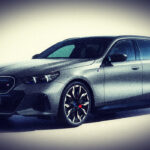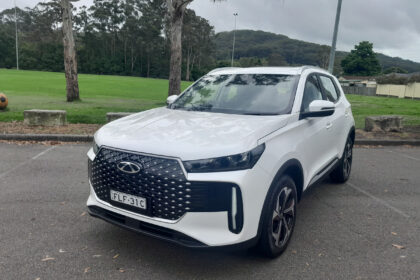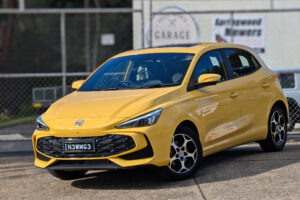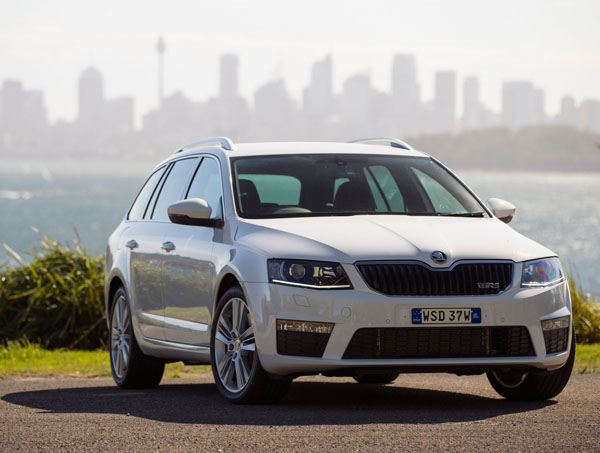
The Skoda Octavia has been given a firm shove in the back with the introduction of a new RS model. The third generation RS is the fastest production Octavia ever and is the culmination of 113 years of Skoda motorsport experience.
It’s sold in Australia as a sedan and station wagon. Powered by a petrol or diesel engine, the flagship Octavia RS will roar from zero to 100 kilometres per hour in 6.8 and 8.3 seconds respectively, all the while bringing a new level of fuel economy and low emissions to the brand.
The latter draws on the Octavia RS’s start / stop engine technology and brake energy recuperation systems of both engines, which are mated respectively with a six-speed manual or dual-clutch transmission, or just an automatic transmission.
 Both the sedan and wagon have the looks to match the model’s sporting ethos, something I found out while driving a diesel powered wagon with DSG, which comes to market at a touch over $41,000, before fees and taxes.
Both the sedan and wagon have the looks to match the model’s sporting ethos, something I found out while driving a diesel powered wagon with DSG, which comes to market at a touch over $41,000, before fees and taxes.
STYLING
There is no mistaking the Octavia RS’s intention, with unique design features leaving their sporting stamp on both sedan and wagon. Sitting lower on the road than the standard model, the wagon is longer by 86 mm and wider, 45 mm, with the wheelbase extended by 102 mm resulting in a shorter front overhang.
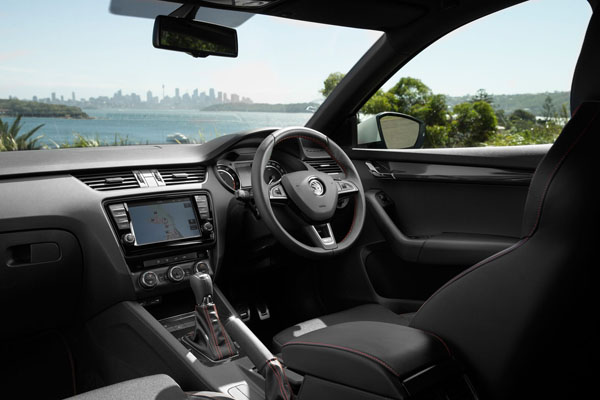
Central to the front end is a characteristic Skoda grille, air inlets with a honeycomb structure, a new apron and foglights in RS design, as well as new bi-xenon headlamps with integrated LED daytime running lights.
RS badging, duplicated on the rear, and stand-out red brake callipers, complete the sporty exterior. Inside is replete with similar pointers, including newly designed RS sport seats in a standard quality fabric and leather trim combination. Alcantara leather with red contrast stitching is an option.
Further markers include a stylish three-spoke steering wheel with perforated leather and an instrument cluster with a colour multi-function display, the RS badge again popping up on the steering wheel, gearshift, door sill plates, seats, and floor mats.
Clever features of the cabin include a door-mounted rubbish bin with removable plastic liner and a holder in the centre console that takes a range of mobile phones and portable media players.
ENGINE / TRANSMISSION
The 2.0-litre diesel engine can hold its head high among others of the ilk with 135 kW on tap at 4000 rpm and 380 Nm at hand from 1750 to 3000 revs, producing up to ten per cent more power while saving up to 17 per cent in fuel over the predecessor. Standard start / stop engine technology and brake energy recuperation systems put in their penn’orth here.
Over the years the Volkswagen/Skoda DSG double-clutch transmission has come ahead in leaps and bounds from its rather stumbling start. The six-speed version in the RS wagon is as good as it gets in automatic mode. Paddle shifts add little to the driving experience.
SAFETY
Standard fitment of newly developed active safety systems include the multi-collision brake with automatic braking action engaged following an accident, Passenger Protect Assist and Fatigue Detection. Front Assist with emergency braking is also available in an optional Tech Pack.
In a crash, nine airbags working with seatbelts help to protect driver and passengers from injuries. The upshot is the entire Octavia range now boasts a five-star ANCAP safety rating.
INFOTAINMENT
The standard Columbus radio / navigation system uses an 8-inch high resolution touch screen with proximity sensors activated when a hand approaches the screen.
A DVD player takes the place of the CD player, and there’s media connection including Apple video function, menu guidance, two SD card slots, Bluetooth high-end telephone function, voice control, a JPEG viewer and an internal 64 Gb flash memory.
DRIVING
With the stop / start function in action the engine is fired up and ready to go almost instantaneously when you lift off the brakes – unlike some that jerk into action almost as an afterthought.
With the DSG transmission slipping smoothly from cog to cog the wagon went about its business quietly and efficiently, clocking up fuel consumption of anything from the low five litres per 100 kilometres to seven-plus in a mix of town and country conditions. However, beyond 3500 rpm, performance did tend to slip.
The wagon’s relaxed going and precise handling can be put down to a MacPherson front axle with lower triangular wishbone suspension and a rear axle with a newly developed multi-link suspension.
An extended electronic differential lock, part of the electronic stabilisation control, and new progressive steering, imbue driver confidence when pushing the wagon hard.
Occupants are well catered for with more space over the previous model and an upgraded passenger shell and a suite of active safety measures earning the wagon a maximum five-star ANCAP rating.
SUMMING UP
The Race Blue test vehicle had just the right amount of attitude and class for a sports wagon, without the weight of a premium price.
AT A GLANCE
MODEL RANGE
Octavia RS 162 TSI 2.0-litre petrol four-door sedan: $36,490 (manual), $38,790 (DSG automatic)
Octavia RS 135 TDI 2.0-litre diesel four-door sedan: $39,790 (DSG automatic)
Octavia RS 162 TSI 2.0-litre petrol five-door wagon: $37,840 (manual), $40,140 (DSG automatic)
Octavia RS 135 TDI 2.0-litre diesel five-door wagon: $41,140 (DSG automatic)
Note: These prices do not include dealer or government charges. Contact your local Skoda dealer for drive-away prices.
FEATURES ABS Brakes: Standard in all models Automatic Transmission: $2300 Optional in 162 TSI, standard in 135 TDI
Cruise Control: Standard in all models Dual Front Airbags: Standard in all models Front Side Airbags: Standard in all models Electronic Stability Program: Standard in all models Rear Parking Sensors: Standard in all models Reversing Camera: Not offered
Auxiliary Audio Input: Standard in all models Bluetooth: Standard in all models Steering Wheel Mounted Controls: Standard in all models
SPECIFICATIONS (Skoda Octavia RS 135TDI DSG wagon turbo-diesel engine)
Capacity: 1968 cc
Configuration: Four-cylinder diesel engine with variable vane turbocharger, in-line, liquid cooling system, high-pressure direct injection system, DOHC, transverse, front
Maximum Power: 135 kW @ 4000 rpm
Maximum Torque: 380 Nm @ 1750-3000 rpm
DRIVELINE:
Transmission: Six-speed DSG, front-wheel drive
DIMENSIONS, WEIGHT AND CAPACITIES:
Length: 4685 mm
Width: 1814 mm
Wheelbase: 2680 mm
Track: 1535 mm (front) / 1506 (rear)
Tare mass: 1503 kg
Max roof load: 75 kg
Towing capacity: 1600 kg (braked); 740 kg (unbraked)
Cargo capacity: 588 litres (rear seats up); 1718 litres (rear seats folded)
Fuel Tank Capacity: 50 litres
Turning circle: 10.6 m
Drag co-efficient: Cd 0.315
SUSPENSION AND BRAKES:
Suspension: MacPherson suspension with lower triangular links and torsion stabiliser. Lowered sports suspension with adaptive chassis control (front) / Independent, four-link with coil springs, anti-roll bar. Lowered Sports suspension with adaptive chassis control (rear)
Brakes: Hydraulic dual-diagonal circuit braking system vacuum assisted with Dual Rate system. Disc brakes with inner cooling, with single/piston floating calliper (front). Disc brakes (rear). Anti-lock braking with Brake Assist, Vehicle Stability Control, Traction Control System, Electronic Differential Lock, Hill Holder
Steering: Direct rack-and-pinion steering with electro mechanic power steering
Wheels: 7.5Jx18in alloy. Space saver spare
Tyres: 225/40 R18
PERFORMANCE
Acceleration 0 to 100 km/h: 8.3 seconds
Top speed: 228 km/h
FUEL CONSUMPTION:
Fuel type: Diesel
Combined Cycle (ADR 81/01): 5.3 litres per 100 km. CO2 emissions 137 g/km
Emissions: Euro V
GREEN VEHICLE GUIDE RATINGS:
Greenhouse Rating: 8.0 / 10
Air Pollution Rating: 6.0 / 10
STANDARD WARRANTY:
Three years / 100,000 kilometres




